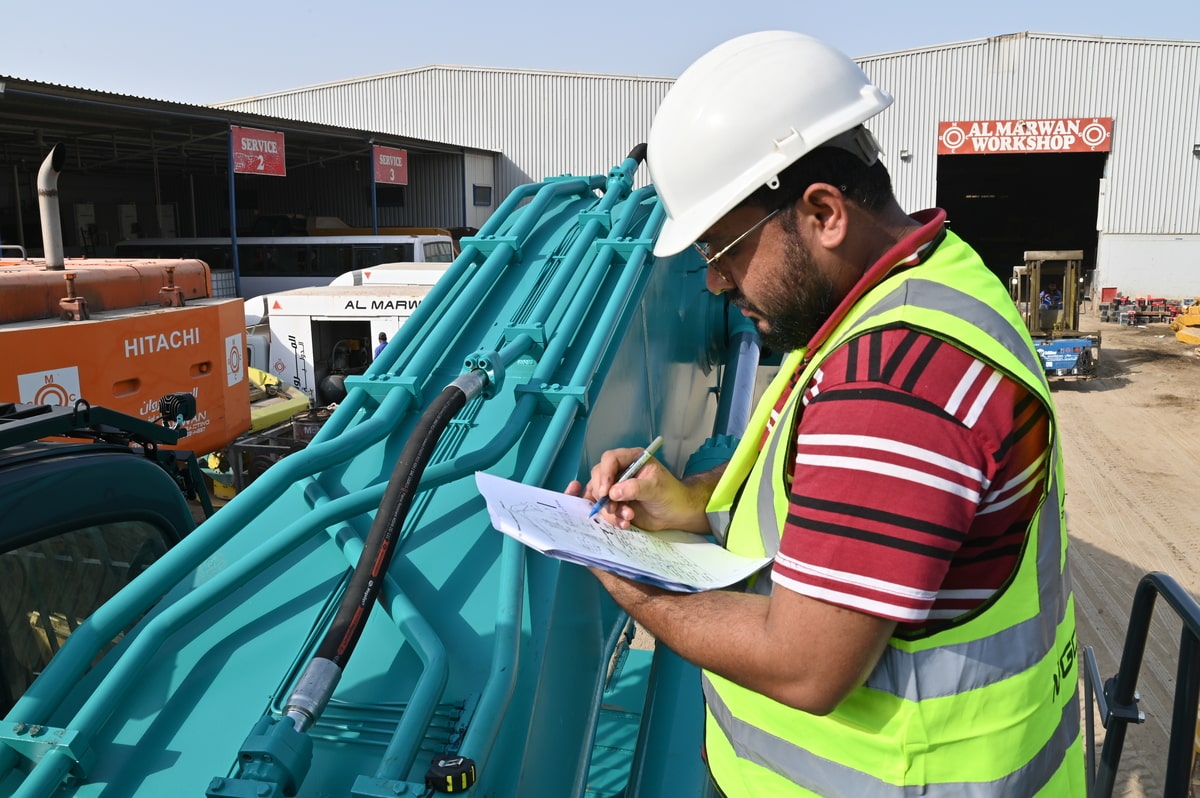Explore key projects shaping Saudi Arabia’s future and the heavy machinery powering their success.
Explore key projects shaping Saudi Arabia’s future and the heavy machinery powering their success.
Saudi Arabia’s construction landscape is transforming rapidly with mega projects contributing to the kingdom’s Vision 2030. These projects are reshaping the nation’s infrastructure, economy, and urban planning. This article takes a closer look at some of the top construction endeavors currently underway in Saudi Arabia and highlights the essential heavy machinery involved in their execution.
- Neom
Neom is one of the largest projects in the world, aimed at building a futuristic city in the Tabuk province. It spans 26,500 square kilometers and includes urban areas, industrial zones, and tourism destinations. Heavy machinery like crawler cranes are indispensable for lifting massive components required for the city’s advanced infrastructure. These cranes play a vital role in constructing Neom’s sprawling development, ensuring high-precision work on complex high-rise buildings.
- Red Sea Project
The Red Sea Project is another cornerstone of Saudi Arabia’s ambitious plans. This massive luxury tourism development is focused on sustainability and preserving natural beauty. Excavators are a key piece of equipment here, as they help shape the terrain while preserving the natural environment. These machines are essential for preparing the foundation for the luxury hotels and villas that will make up the project’s core.
- Qiddiya
The Qiddiya project is set to be Saudi Arabia’s entertainment hub, complete with theme parks, sports arenas, and residential zones. Heavy machinery like cranes play a critical role in erecting large entertainment complexes and arenas. These machines enable the swift and safe construction of towering structures, which are pivotal to the project’s success. The use of advanced cranes ensures the proper installation of critical components for entertainment facilities and arenas.
- King Salman Energy Park (SPARK)
This project is designed to become a global energy hub, offering industrial and commercial services. The project covers 50 square kilometers and is expected to generate jobs and boost the economy. Heavy-duty excavators and road construction equipment are central to shaping the vast land and preparing it for industrial use. Road construction machinery is also crucial for laying down the transport infrastructure within the park.
- Jeddah Tower
The Jeddah Tower, which aims to be the tallest building in the world, is a key component of the Jeddah Economic City project. Standing over 1,000 meters high, this tower requires state-of-the-art lifting equipment. Crawler cranes are vital for transporting construction materials to unprecedented heights. These cranes are integral to the project, ensuring the construction is carried out safely and efficiently.
- Riyadh Metro
The Riyadh Metro is a massive transportation project covering 176 kilometers with six metro lines. Excavators and tunneling machines are essential in this project to dig through dense urban landscapes and ensure the metro’s underground system is built efficiently. Additionally, road construction equipment is key to building the extensive above-ground metro infrastructure.
- Al Widyan
Located in Riyadh, Al Widyan is a mixed-use city project. This development includes residential, commercial, and entertainment facilities spread over 7 million square meters. Excavators are instrumental in shaping the terrain and preparing the site for construction. Heavy machinery is also necessary for road construction, ensuring efficient transportation links within this sprawling development.
- Roshn Residential Communities
Roshn is a residential development project aimed at providing affordable housing across Saudi Arabia. With several projects located in Riyadh, Jeddah, and other major cities, machinery such as excavators and cranes are essential. The cranes are used for erecting housing units, while excavators handle the earthmoving and site preparation tasks. Efficient use of machinery ensures rapid construction to meet the growing housing demand.
- Diriyah Gate Development
This historic project focuses on revitalizing the Diriyah area, the birthplace of the first Saudi state. The construction work includes the development of luxury hotels, restaurants, and cultural venues. Specialized cranes are used to lift structural components into place without damaging the historical surroundings. The project is sensitive to its environment, requiring precision in machinery operation.
- King Abdullah Economic City (KAEC)
Located along the Red Sea coast, KAEC is designed to be a leading business hub. The project spans over 173 square kilometers and includes residential, commercial, and leisure spaces. Cranes and excavators are essential here, helping build the large industrial zones and commercial areas, ensuring smooth construction in this vast development.
- Makkah Grand Mosque Expansion
The Makkah Grand Mosque expansion is a critical religious and cultural project, aimed at accommodating millions of pilgrims every year. Cranes are used extensively to erect the new structures within the expansion, lifting massive marble columns and other key components into place with precision. These cranes ensure the project is completed without disrupting the operations of the mosque.
- King Faisal Medical City
This healthcare city in the southern region of Saudi Arabia is expected to offer world-class medical services. With several high-rise buildings, cranes are vital for installing structural components at various heights, ensuring the project meets its stringent construction timelines.
- Riyadh Sports Boulevard
The Riyadh Sports Boulevard is designed to promote outdoor activities and sports. The construction of parks, sports complexes, and public areas requires heavy machinery such as excavators and cranes for shaping the terrain and building the infrastructure. The project aims to provide a healthier lifestyle for residents.
- Amaala
Amaala is a luxury tourism project located on the northwestern coast of Saudi Arabia. Excavators are pivotal in preparing the foundations for hotels and villas, while road construction equipment ensures access to various project sites. The project emphasizes sustainability, requiring specialized machinery that minimizes environmental disruption.
- Sharaan Nature Reserve Development
This project focuses on developing a luxury tourism resort within a protected nature reserve in AlUla. Specialized construction equipment is required to ensure minimal disruption to the surrounding environment. Cranes and earthmovers are essential to creating the resort’s infrastructure while preserving the natural landscape.
- Jazan City for Primary and Downstream Industries
Jazan City is an industrial project focusing on the oil and gas sector. The project includes infrastructure for refining and processing plants. Cranes and heavy-duty industrial equipment are vital in this project, used to transport and install large components in the petrochemical sector.
- Riyadh Front
The Riyadh Front is a commercial project aimed at expanding the capital’s business and retail spaces. Heavy machinery such as cranes and excavators are used extensively in the construction of commercial towers and malls. Road construction machinery ensures proper access roads to facilitate smooth transport links within the business district.
- Red Sea International Airport
As part of the Red Sea Project, the new international airport is designed to accommodate luxury tourism. Earthmoving equipment such as excavators is necessary to prepare the site for runway construction, while cranes are used to build the airport’s terminals and associated infrastructure.
- Ad Diriyah Masterplan
The Ad Diriyah Masterplan focuses on developing a cultural and tourism hub near Riyadh. The project includes museums, luxury hotels, and entertainment venues. Cranes are crucial in erecting large structures without damaging the surrounding heritage areas, ensuring the seamless integration of modern facilities.
- Qurayyat-Riyadh Railway
This massive transportation project is designed to connect the northern region of Saudi Arabia with Riyadh. The railway spans hundreds of kilometers, requiring excavators and road construction machinery to prepare the tracks and stations. Heavy-duty cranes are essential for lifting railway components into place during the construction process.
Saudi Arabia’s Vision 2030 is being brought to life through these remarkable construction projects that are reshaping the nation. The use of heavy machinery—particularly cranes and excavators—plays a crucial role in ensuring these ambitious projects are completed efficiently and safely. From building futuristic cities like Neom to expanding the Makkah Grand Mosque, these machines enable the creation of essential infrastructure, connecting regions and enhancing the country’s economic, cultural, and social landscape. As these projects continue to unfold, the strategic use of advanced machinery will remain a cornerstone in achieving the vision of a modern and integrated Saudi Arabia.








